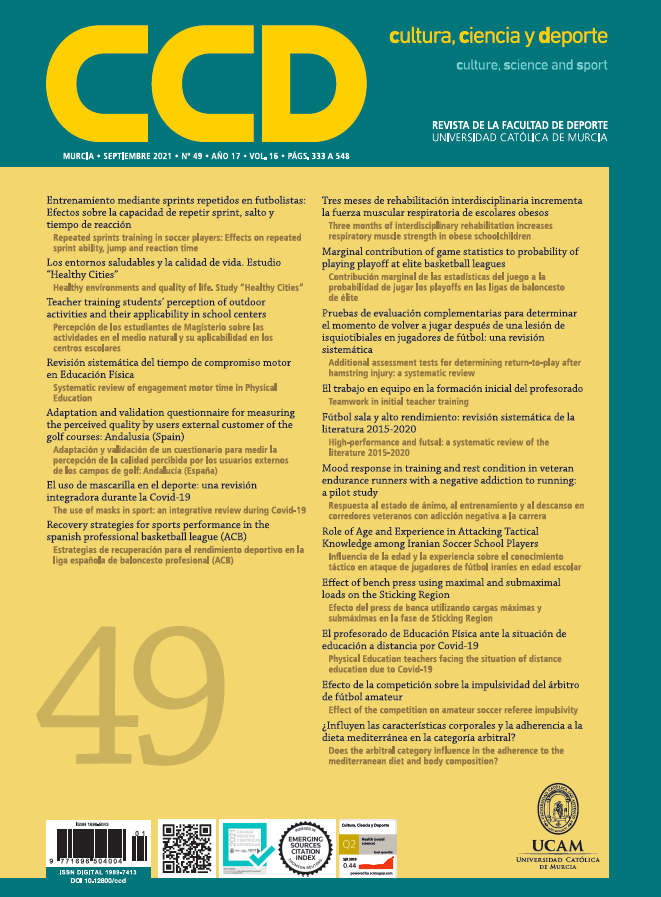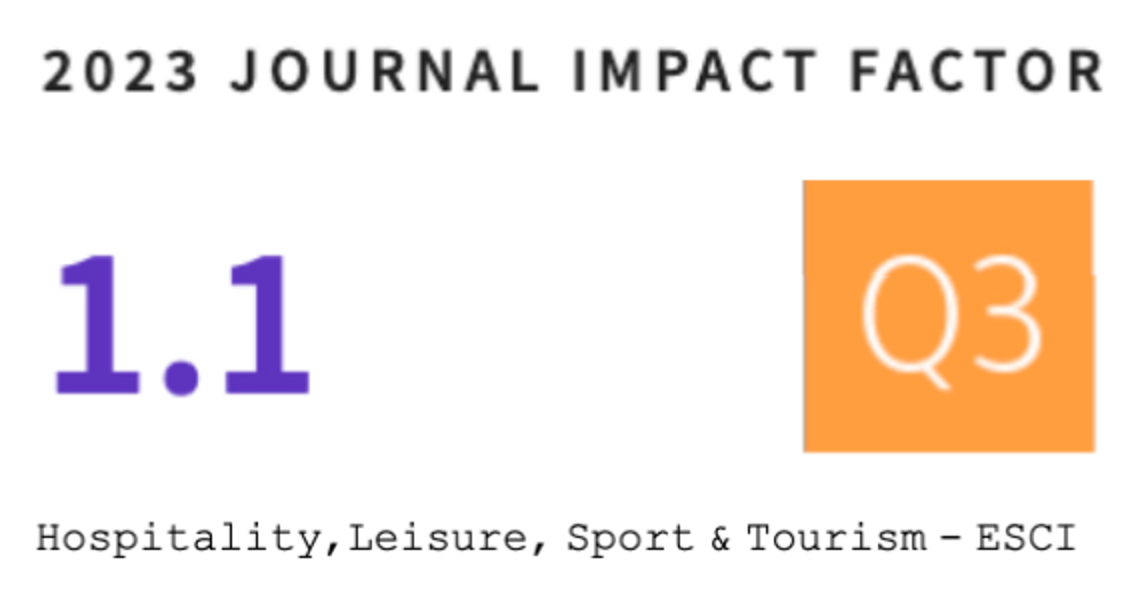Recovery strategies for sports performance in the spanish professional basketball league (ACB)
DOI:
https://doi.org/10.12800/ccd.v16i49.1643Palabras clave:
recovery methods, professional players, survey, team sports, questionnaireResumen
This study aimed to describe the recovery strategies used by the Spanish professional basketball teams playing in the “Liga ACB.” Data from all teams during the 2019-2020 season (n = 18), and the team promoted for the season 2020-2021 were collected using a six-section online survey. Protocols, timings, and recovery strategies employed differed among teams. However, natural and physical recovery strategies such as sleep/nap, food/fluid replacement, active field, or gym-based cool-downs, use of supplementation, active or passive stretching, cold/ice bath/shower/immesion, massage, and foam-rolling were the most used among seventeen teams (>89%). Food and fluid replacement, showed a higher presence in the recovery protocols after competition and practice, always used by thirteen or more teams (~70%). The design and supervision of recovery are multidisciplinary tasks in 74% of the teams. Only two teams (11%) acknowledged not periodizing or individualizing recovery, while the other seventeen used these procedures regularly, considering different parameters, being previous injuries a factor always present. Teams not reaching the playoffs used a higher number of recovery strategies on average. This study provides a real vision of how the “Liga ACB” teams use recovery protocols, and pertinent contextual information that may be used for coaches and practitioners to tailor them.
Citas
Alarcón, F., Ureña, N., & Cárdenas, D. (2017). Mental fatigue impairs the basketball free-throw performance. Journal of Sport Psychology, 26(Suppl 1), 33–36.
Altarriba-Bartes, A., Peña, J., Vicens-Bordas, J., Casals, M., Peirau, X., & Calleja-González, J. (2020). The use of recovery strategies by Spanish first division soccer teams: a cross-sectional survey. The Physician and Sportsmedicine, 1–11. doi:10.1080/00913847.2020.1819150
Altarriba-Bartes, A., Peña, J., Vicens-Bordas, J., Milà-Villaroel, R., & Calleja-González, J. (2020). Post-competition recovery strategies in elite male soccer players. Effects on performance: A systematic review and meta-analysis. PLoS ONE, 15(10 October). doi:10.1371/journal.pone.0240135
Bahnert, A., Norton, K., & Lock, P. (2013). Association between post-game recovery protocols, physical and perceived recovery, and performance in elite Australian Football League players. Journal of Science and Medicine in Sport, 16(2), 151–156. doi:10.1016/j.jsams.2012.05.008
Barnett, A. (2006). Using recovery modalities between training sessions in elite athletes: does it help? Sports Medicine, 36(9), 781–796. doi:10.2165/00007256-200636090-00005
Baumeister, R. F., Vohs, K. D., & Tice, D. M. (2007). The Strength Model of Self-Control. Current Directions in Psychological Science, 16(6), 351–355. doi:10.1111/j.1467-8721.2007.00534.x
Ben Abdelkrim, N., El Fazaa, S., El Ati, J., & Tabka, Z. (2007). Time-motion analysis and physiological data of elite under-19-year-old basketball players during competition * Commentary. British Journal of Sports Medicine, 41(2), 69–75. doi:10.1136/bjsm.2006.032318
Bishop, P. A., Jones, E., & Woods, A. K. (2008). Recovery from training: a brief review: brief review. Journal of Strength and Conditioning Research, 22(3), 1015–1024. doi:10.1519/JSC.0b013e31816eb518
Brito, J., Hertzog, M., & Nassis, G. P. (2016). Do match-related contextual variables influence training load in highly trained soccer players? Journal of Strength and Conditioning Research, 30(2), 393–399. doi:10.1519/JSC.0000000000001113
Bryer, J., & Speerschneider, K. (2016). Package ‘likert’. A nalysis and visualization Likert items. CRAN. https://cran.r-project.org/
Calleja-Gonzalez, J., Marques-Jimenez, D., Jones, M., Huyghe, T., Navarro, F., Delextrat, A., Jukic, I., Ostojic, S. M., Sampaio, J. E., Schelling, X., Alcaraz, P. E., Sanchez-Bañuelos, F., Leibar, X., Mielgo-Ayuso, J., & Terrados, N. (2020). What are we doing wrong when athletes report higher levels of fatigue from traveling than from training or competition? Frontiers in Psychology, 11. doi:10.3389/fpsyg.2020.00194
Calleja-González, J., Mielgo-Ayuso, J., Ostojic, S. M., Jones, M. T., Marques-Jiménez, D., Caparros, T., & Terrados, N. (2019). Evidence-based post-exercise recovery strategies in rugby: a narrative review. The Physician and Sportsmedicine, 47(2), 137–147. doi:10.1080/00913847.2018.1541701
Calleja-González, J., Mielgo-Ayuso, J., Sampaio, J., Delextrat, A., Ostojic, S. M., Marques-Jiménez, D., Arratibel, I., Sánchez-Ureña, B., Dupont, G., Schelling, X., & Terrados, N. (2018). Brief ideas about evidence-based recovery in team sports. Journal of Exercise Rehabilitation, 14(4), 545–550. doi:10.12965/jer.1836244.122
Calleja-González, J., Terrados, N., Martín-Acero, R., Lago-Peñas, C., Jukic, I., Mielgo-Ayuso, J., Marqués-Jiménez, D., Delextrat, A., & Ostojic, S. (2018). Happiness vs. wellness during the recovery process in high performance sport. Frontiers in Physiology, 9. doi:10.3389/fphys.2018.01598
Calleja-González, J., Terrados, N., Mielgo-Ayuso, J., Delextrat, A., Jukic, I., Vaquera, A., Torres, L., Schelling, X., Stojanovic, M., & Ostojic, S. M. (2016). Evidence-based post-exercise recovery strategies in basketball. The Physician and Sportsmedicine, 44(1), 74–78. doi:10.1080/00913847.2016.1102033
Chen, Lu, Clemente, Bezerra, & Kuo. (2019). Increased parasympathetic activity by foot reflexology massage after repeated sprint test in collegiate football players: a randomised controlled trial. Sports, 7(11), 228. doi:10.3390/sports7110228
Clarke, N., & Noon, M. (2019). Editorial: Fatigue and recovery in football. Sports, 7(8), 192. doi:10.3390/sports7080192
Cormery, B., Marcil, M., & Bouvard, M. (2007). Rule change incidence on physiological characteristics of elite basketball players: a 10-year-period investigation. British Journal of Sports Medicine, 42(1), 25–30. doi:10.1136/bjsm.2006.033316
Crowther, F., Sealey, R., Crowe, M., Edwards, A., & Halson, S. (2017). Team sport athletes’ perceptions and use of recovery strategies: a mixed-methods survey study. BMC Sports Science, Medicine and Rehabilitation, 9(1), 6. doi:10.1186/s13102-017-0071-3
Delextrat, A., Calleja-González, J., Hippocrate, A., & Clarke, N. D. (2013). Effects of sports massage and intermittent cold-water immersion on recovery from matches by basketball players. Journal of Sports Sciences, 31(1), 11–19. doi:10.1080/02640414.2012.719241
Delextrat, A., Mackessy, S., Arceo-Rendon, L., Scanlan, A., Ramsbottom, R., & Calleja-Gonzalez, J. (2018). Effects of three-day serial sodium bicarbonate loading on performance and physiological parameters during a simulated basketball test in female university players. International Journal of Sport Nutrition and Exercise Metabolism, 28(5), 547–552. doi:10.1123/ijsnem.2017-0353
Delextrat, A., Trochym, E., & Calleja-González, J. (2012). Effect of a typical in-season week on strength jump and sprint performances in national-level female basketball players. The Journal of Sports Medicine and Physical Fitness, 52(2), 128–136. http://www.ncbi.nlm.nih.gov/pubmed/22525647
di Fronso, S., Nakamura, F. Y., Bortoli, L., Robazza, C., & Bertollo, M. (2013). Stress and recovery balance in amateur basketball players: differences by gender and preparation phase. International Journal of Sports Physiology and Performance, 8(6), 618–622. doi:10.1123/ijspp.8.6.618
Esteves, P. T., Mikolajec, K., Schelling, X., & Sampaio, J. (2020). Basketball performance is affected by the schedule congestion: NBA back-to-backs under the microscope. European Journal of Sport Science, 1–10. doi:10.1080/17461391.2020.1736179
Euroleague. (2013). ECA Shareholders meeting ushers in new season. https://www.euroleaguebasketball.net/ euroleague-basketball/news/i/114696/eca-shareholders-meeting-ushers-in-new-season
Ferioli, D., Rampinini, E., Bosio, A., La Torre, A., Azzolini, M., & Coutts, A. J. (2018). The physical profile of adult male basketball players: Differences between competitive levels and playing positions. Journal of Sports Sciences, 36(22), 2567–2574. doi:10.1080/02640414.2018.1469241
FIBA. (2020). FIBA. https://www.fiba.basketball/es/documents
FIBA. (2021). Hosts for February 2021 FIBA European Qualifiers windows tournaments confirmed. http://www.fiba.basketball/news/hosts-for-february-2021-fiba-european-qualifiers-windows-tournaments-confirmed
Foster, C., Boullosa, D., McGuigan, M., Fusco, A., Cortis, C., Arney, B. E., Orton, B., Dodge, C., Jaime, S., Radtke, K., van Erp, T., de Koning, J. J., Bok, D., Rodriguez-Marroyo, J. A., & Porcari, J. P. (2020). 25 years of session rating of perceived exertion: historical perspective and development. International Journal of Sports Physiology and Performance, 1–10. doi:10.1123/ijspp.2020-0599
Greenway, K., Butt, G., & Walthall, H. (2019). What is a theory-practice gap? An exploration of the concept. Nurse Education in Practice, 34, 1–6. doi:10.1016/j.nepr.2018.10.005
Haddad, M., Stylianides, G., Djaoui, L., Dellal, A., & Chamari, K. (2017). Session-RPE method for training load monitoring: validity, ecological usefulness, and influencing factors. Frontiers in Neuroscience, 11. doi:10.3389/fnins.2017.00612
Halson, S. (2015). Recovery techniques for athletes. Aspetar Sports Medicine Journal, 4, 12–16.
Hellmann, F., Verdi, M., Schlemper Junior, B. R., & Caponi, S. (2014). 50th anniversary of the Declaration of Helsinki: the double standard was introduced. Archives of Medical Research, 45(7), 600–601. doi:10.1016/j.arcmed.2014.10.005
Holway, F. E., & Spriet, L. L. (2011). Sport-specific nutrition: Practical strategies for team sports. Journal of Sports Sciences, 29(sup1), S115–S125. doi:10.1080/02640414.2011.605459
Howle, K., Waterson, A., & Duffield, R. (2019). Recovery profiles following single and multiple matches per week in professional football. European Journal of Sport Science, 19(10), 1303–1311. doi:10.1080/17461391.2019.1601260
Jentjens, R., & Jeukendrup, A. E. (2003). Determinants of post-exercise glycogen synthesis during short-term recovery. Sports Medicine, 33(2), 117–144. doi:10.2165/00007256-200333020-00004
Kellmann, M. (2010). Preventing overtraining in athletes in high-intensity sports and stress/recovery monitoring. Scandinavian Journal of Medicine & Science in Sports, 20, 95–102. doi:10.1111/j.1600-0838.2010.01192.x
Kellmann, Michael, Altenburg, D., Lormes, W., & Steinacker, J. M. (2001). Assessing stress and recovery during preparation for the World Championships in rowing. The Sport Psychologist, 15(2), 151–167. doi:10.1123/tsp.15.2.151
Kellmann, Michael, Bertollo, M., Bosquet, L., Brink, M., Coutts, A. J., Duffield, R., Erlacher, D., Halson, S. L., Hecksteden, A., Heidari, J., Kallus, K. W., Meeusen, R., Mujika, I., Robazza, C., Skorski, S., Venter, R., & Beckmann, J. (2018). Recovery and performance in sport: consensus statement. International Journal of Sports Physiology and Performance, 13(2), 240–245. doi:10.1123/ijspp.2017-0759
Koopman, R., Wagenmakers, A. J. M., Manders, R. J. F., Zorenc, A. H. G., Senden, J. M. G., Gorselink, M., Keizer, H. A., & van Loon, L. J. C. (2005). Combined ingestion of protein and free leucine with carbohydrate increases postexercise muscle protein synthesis in vivo in male subjects. American Journal of Physiology-Endocrinology and Metabolism, 288(4), E645–E653. doi:10.1152/ajpendo.00413.2004
Lin, Z.-P., Lan, L. W., He, T.-Y., Lin, S.-P., Lin, J.-G., Jang, T.-R., & Ho, T.-J. (2009). Effects of acupuncture stimulation on recovery ability of male elite basketball athletes. The American Journal of Chinese Medicine, 37(03), 471–481. doi:10.1142/S0192415X09006989
Liu, H., Garrett, W. E., Moorman, C. T., & Yu, B. (2012). Injury rate, mechanism, and risk factors of hamstring strain injuries in sports: a review of the literature. Journal of Sport and Health Science, 1(2), 92–101. doi:10.1016/j.jshs.2012.07.003
Martin, J. (2012). Power ranking the best basketball leagues in the world, outside of the NBA. https://bleacherreport.com/articles/1291287-power-ranking-the-best-basketball-leagues-in-the-world-outside-of-the-nba
McKeag, D. B. (2003). Handbook of sports medicine and science, basketball (D. B. McKeag (Ed.)). Wiley-Blackwell.
Montgomery, P. G., Pyne, D. B., Hopkins, W. G., Dorman, J. C., Cook, K., & Minahan, C. L. (2008). The effect of recovery strategies on physical performance and cumulative fatigue in competitive basketball. Journal of Sports Sciences, 26(11), 1135–1145. doi:10.1080/02640410802104912
Moreira, A., Aoki, M. S., Franchini, E., da Silva Machado, D. G., Paludo, A. C., & Okano, A. H. (2018). Mental fatigue impairs technical performance and alters neuroendocrine and autonomic responses in elite young basketball players. Physiology & Behavior, 196, 112–118. doi:10.1016/j.physbeh.2018.08.015
Moreno, J., Ramos-Castro, J., Rodas, G., Tarragó, J. R., & Capdevila, L. (2015). Individual recovery profiles in basketball players. The Spanish Journal of Psychology, 18, E24. doi:10.1017/sjp.2015.23
Mujika, I., & Burke, L. M. (2010). Nutrition in team sports. Annals of Nutrition and Metabolism, 57(s2), 26–35. doi:10.1159/000322700
Mujika, I., Halson, S., Burke, L. M., Balagué, G., & Farrow, D. (2018). An integrated, multifactorial approach to periodization for optimal performance in individual and team sports. International Journal of Sports Physiology and Performance, 13(5), 538–561. doi:10.1123/ijspp.2018-0093
Nikolaidis, P. T., Asadi, A., Santos, E. J. A. M., Calleja-González, J., Padulo, J., Chtourou, H., & Zemkova, E. (2015). Relationship of body mass status with running and jumping performances in young basketball players. Muscles, Ligaments and Tendons Journal, 5(3), 187–194. doi:10.11138/mltj/2015.5.3.187
Opar, D. A., Williams, M. D., & Shield, A. J. (2012). Hamstring strain injuries. Sports Medicine, 42(3), 209–226. doi:10.2165/11594800-000000000-00000
Pelka, M., Heidari, J., Ferrauti, A., Meyer, T., Pfeiffer, M., & Kellmann, M. (2016). Relaxation techniques in sports: A systematic review on acute effects on performance. Performance Enhancement & Health, 5(2), 47–59. doi:10.1016/j.peh.2016.05.003
Poppendieck, W., Wegmann, M., Ferrauti, A., Kellmann, M., Pfeiffer, M., & Meyer, T. (2016). Massage and performance recovery: a meta-analytical review. Sports Medicine, 46(2), 183–204. doi:10.1007/s40279-015-0420-x
Sansone, P., Tschan, H., Foster, C., & Tessitore, A. (2020). Monitoring training load and perceived recovery in female basketball: implications for training design. Journal of Strength and Conditioning Research, 34(10), 2929–2936. doi:10.1519/JSC.0000000000002971
Starling, L. T., & Lambert, M. I. (2018). Monitoring rugby players for fitness and fatigue: what do coaches want? International Journal of Sports Physiology and Performance, 13(6), 777–782. doi:10.1123/ijspp.2017-0416
Stephens, J. M., Halson, S., Miller, J., Slater, G. J., & Askew, C. D. (2017). Cold-water immersion for athletic recovery: one size does not fit all. International Journal of Sports Physiology and Performance, 12(1), 2–9. doi:10.1123/ijspp.2016-0095
Terrados, N., Mielgo-Ayuso, J., Delextrat, A., Ostojic, S. M., & Calleja-Gonzalez, J. (2019). Dietetic-nutritional, physical and physiological recovery methods post-competition in team sports. The Journal of Sports Medicine and Physical Fitness, 59(3). doi:10.23736/S0022-4707.18.08169-0
Venter, R. E. (2014). Perceptions of team athletes on the importance of recovery modalities. European Journal of Sport Science, 14, S69–S76. doi:10.1080/17461391.2011.643924
Venter, R. E., Potgieter, J. R., & Barnard, J. G. (2009). The use of recovery modalities by elite South African team athletes. South African Journal for Research in Sport, Physical Education and Recreation, 31(1), 133–145. https://www.scopus.com/inward/record.uri?eid=2-s2.0-77951789023&partnerID=40&md5=e626d5f20e73c3fcfb6d5b061d0e042e
White, J. (1998). Alternative sports medicine. Physician and Sportsmedicine, 26(6), 92–105. doi:10.3810/psm.1998.06.1066
WMA. (2013). World Medical Association declaration of Helsinki: Ethical principles for medical research involving human subjects. In JAMA - Journal of the American Medical Association (Vol. 310, Issue 20, pp. 2191–2194). JAMA. doi:10.1001/jama.2013.281053
Zarić, I., Kukić, F., Jovićević, N., Zarić, M., Marković, M., Toskić, L., & Dopsaj, M. (2020). Body height of elite basketball players: do Taller basketball teams rank better at the FIBA World Cup? International Journal of Environmental Research and Public Health, 17(9). doi:10.3390/ijerph17093141
Descargas
Publicado
Cómo citar
Número
Sección
Licencia
Derechos de autor 2021 Creative Commons Attribution License

Esta obra está bajo una licencia internacional Creative Commons Atribución-NoComercial-CompartirIgual 4.0.
Los autores que publican en esta revista están de acuerdo con los siguientes términos:- Los autores conservan los derechos de autor y garantizan a la revista el derecho de ser la primera publicación del trabajo al igual que licenciado bajo una Creative Commons Attribution License que permite a otros compartir el trabajo con un reconocimiento de la autoría del trabajo y la publicación inicial en esta revista.
















